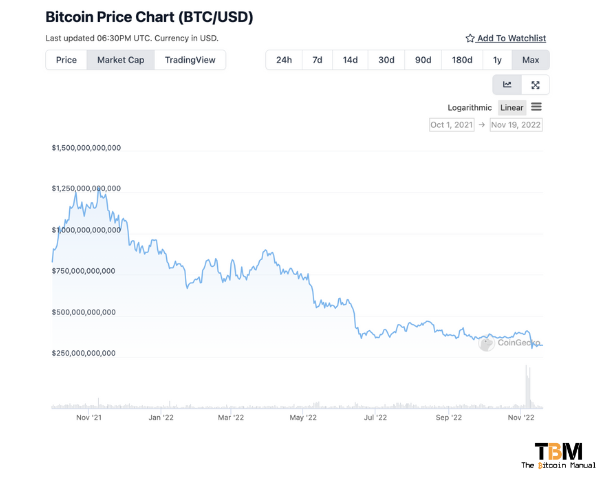It’s been a wild ride these last few years, even for the most seasoned bitcoiner. If this is your first bull and bear cycle, I am sure you feel like you’ve experienced a decade’s worth of drama in this last year alone. Bitcoin is infamous for being highly speculative and volatile. When you tack on the additional leverage that comes with altcoins, you’re only going to amplify that volatility.
Bitcoin was designed to be a bearer asset that can be held by the individual, so you need not trust anyone with your funds. Bitcoins’ value is derived from its inelastic supply and scarcity in what many call NGU technology. Due to its ability to appreciate, there is no do you need to take your bitcoin out of cold storage to chase yield. You can merely enjoy the CAGR as the network expands and more users onboard to a bitcoin standard.
So it’s rather ironic that “debt problems” in bitcoin and cryptocurrency are the reason for these horrific headlines and downward price spiral. It seems not too long ago; the market was riding high on confidence, or perhaps overconfidence. Back in November of 2021, the total value of cryptocurrencies has now fallen from a peak of over US$3 trillion (£2.6 trillion) to circa US$830 billion (£706 billion).
As for bitcoin, it’s been trimmed down from US$1.25 trillion to a pittance of US$300 billion.
The fall in the price of bitcoin has coincided with a major downturn in global markets due to central bank policy changes to combat inflation, resulting in interest rates going up and investors taking risk off the table.
This would see a natural downturn in the market as people trim their positions. Still, falling prices also revealed gross abuse of leverage and hidden frauds, and this resulted in a series of collapses and bankruptcies within the wider cryptocurrency industry, spreading the contagion.

What is market contagion?
In economics, contagion is a chain of events during an economic crisis from one financial institution, market, or region to another. Financial institutions in a certain market are interdependent, and events in one market or institution can impact other markets or institutions.
It is usually associated with credit bubbles and financial crises and can manifest during times of overconfidence; when prices go up and do so consistently, market participants tend to take on more risk, and with more risk comes smaller margins for error. As risk management is thrown to the wayside and profit maximisation is all that matters, when market conditions change, those taking the most risk fail and can drag others along.
Market or financial contagions are typically associated with the diffusion of economic or financial crises throughout a market, asset class, or geographic region. Now that you know what a contagion in financial markets is let’s take a look at the series of events that have unfolded to give you an idea as to why bitcoin has shaved off nearly 80% of its value from the all-time high.
One man’s yield is another man’s leverage
This series of events all started as bitcoin ran up to its new all-time high. With that, it dragged along a host of unsustainable projects that were piggybacking from a market awash with naive investors, both retail and institutional.
The darling of the last bull market was a cryptocurrency project offering unsustainable yield and paying out in a now-collapsed algorithmic stablecoin UST. Terra (Luna) started in early May 75% of the total circulation of Terra was held in a lending and borrowing system called the Anchor Protocol.
Holders of Terra were rewarded for depositing their coins in the Anchor Protocol with a fixed 19.8% interest rate, a rate they could not maintain and top up the subsidy the project was running a massive deficit, hoping to make it up with the sale of more Luna, but the mythical equilibrium of selling Luna to top up UST interest payments never arrived, and they had to make a change.
Rumours that Anchor was changing their fixed interest rates to variable ones, along with a sizable short on the trade, triggered massive withdrawals of Terra. As more people decided to sell their Terra, this caused the supply of Luna to shoot up. The oversupply led both Terra and Luna to a price crash. This vaporised about $40 billion of market value and left many hopeful crypto investors empty-handed.
In addition, the Luna Foundation Guard, a consortium whose job it is to protect the peg, had about $2.3 billion in bitcoin reserves, with plans to expand that to $10 billion worth of bitcoin and other crypto assets. In an attempt to stabilise the price of Luna (and TerraUSD), the Luna Foundation liquated its bitcoin reserves, which caused a significant downturn in bitcoin price and a further bitcoin sell-off of market participants.
But it did not end with Terra and UST.
As prices have fallen, cracks have appeared in the crypto infrastructure. Babel Finance and Celsius, two crypto lenders, have paused withdrawals after struggling to meet redemptions; their rivals have trimmed their balance sheets, causing a credit crunch. Third Arrow, a crypto hedge fund with credit lines with several institutions that failed to meet margin calls, and cascading losses were starting to unravel.
The problems at Luna, Celsius and 3AC and their bankruptcies eventually sent ripples through the market, and those with exposure had to eat the losses.
- Blockchain.com: Crypto exchange Blockchain.com has announced it could lose as much as $270 million as a result of its exposure to 3AC, although CEO Peter Smith said in a shareholder letter that “customers will not be impacted.”
- Genesis: Its role as major 3AC creditor means Genesis potentially faces hundreds of millions of dollars in losses.
- Babel Finance: Hong Kong-based crypto lender froze withdrawals on June 17 due to “unusual liquidity pressures.” Babel was recently reported to have hired restructuring specialist Houlihan Lokey to help determine its next steps.
- CoinFLEX: A crypto futures exchange, CoinFLEX halted withdrawals on June 24 because of “extreme market conditions.” The company is trying to fix a $47 million hole in its balance sheet by issuing a new token that offers a 20% interest rate.
- 8 Blocks Capital: Hong Kong-based 8 Blocks is a crypto trading firm. In May it accused 3AC of improperly taking $1 million to answer their margin calls, then “ghosting” 8 Blocks when it repeatedly tried to contact 3AC for an explanation.
- FinBlox: A crypto staking platform that had loaned an undisclosed sum to 3AC. The company temporarily imposed a $1,500 monthly limit on withdrawals on June 16, and in early July, FinBlox raised the limit to $3,000 as it worked to undo the damage and return to normal operations.
- Deribit: The derivatives exchange Deribit reported in court filings that 3AC had failed to repay a loan of $80 million.
- Vauld: Singapore-based crypto lending platform froze customer accounts on July 4. Recently, crypto lender Nexo signed a term sheet to acquire the troubled firm.
Incestuous institutions
The second channel layer of contagion comes from the high degree of interconnectedness between CeFi and DeFi platforms. This is partly the result of intensifying competition driving the need for yield. The amount of money invested in building out DeFi protocols and providing subsidised yield to bootstrap these services attracted a massive amount of interest from both retail and institutional investors.
Some retailers choose to participate directly in DEFI, while others receive exposure through a custodial proxy like a CeFi lender or an exchange.
As crypto lenders have vied to attract more capital to dump into these platforms, they have promised ever-higher yields to depositors, which, in turn, has led them to invest users’ funds in riskier projects—typically other lending and yield-generating platforms.
When the price of one asset falls, for example, Luna or FTT token, the effects cascade through the system.
THERE'S NO TIME TO EXPLAIN JUST GET ON THE SWAN pic.twitter.com/XAB7cf9HN4
— Cory at Swan Bitcoin (@coryklippsten) November 19, 2022
Since the collapse of FTT, we’ve seen several firms dragged down with FTX:
- BlockFi: Recently operating with a line of credit from FTX, has paused withdrawals
- Coinhouse: Coinhouse suspends “savings accounts” due to Genesis’s suspension from exposure to the FTX collapse.
- Nestcoin: Nigerian startup Nestcoin had nearly all of the funds remaining from their investing round locked on FTX.
- Digital Surge: The Brisbane-based cryptocurrency exchange Digital Surge announced that they would be suspending deposits and withdrawals due to FTX exposure
- Gemini Earn: Gemini exchange halts withdrawals from their lending service
- SALT: The crypto lending firm announced that they would be halting withdrawals due to exposure to FTX
- Ikigai: Asset Management announces “large majority” of assets trapped in FTX
- Huobi: Announced that they have $18.1 million locked on FTX, which are mostly customer funds
The market has to step in and catch the falling knife
The third reason for the spread of contagion is the lack of a liquidity backstop to prevent a free fall in asset prices. In mainstream finance, regulators, central banks and governments provide a safety net. In conventional finance, such fail-safes reduce the risk of panic-selling when prices tumble.
When we experienced systemic risk during the 2008 Financial Crisis, we saw widespread global contagion. The collapse of Lehman Brothers in October of 2008 led to a major systemic risk, which spread not only throughout the financial industry but worldwide. It was a consequence of the interdependency and interconnectivity of Lehman Brothers with other financial institutions and counterparties and the interdependency of those institutions with other counterparties.
With this type of interconnectivity, it’s enough that if one fails, it triggers a domino effect that leads to the collapse of the entire financial system. The federal reserve and other central banks had to step in and provide liquidity while taking on those distressed assets.
But in bitcoin, there is no central institution that exists to mop up stressed bitcoin assets. Deposits with crypto lenders are not insured, lost bitcoin cannot be recovered, and new bitcoin cannot be created on demand to fill gaps. While buyers are still willing to provide liquidity to the market and help stabilise the price, it doesn’t mean there isn’t another leg down.
Should bitcoin continue to drop below $15,000, liquidations could accelerate so much that posting enough collateral or raising funds to stop the fall may become hard, forcing even more participants to sell their positions.
Tick tock next block
The current crypto contagion poses no systemic risk for bitcoin the asset nor bitcoin the network, which are both functioning according to consensus, and the network is as secure as ever. The contagion is limited to the various businesses that hold bitcoin and actively trade it or make markets with bitcoin and fiat, stablecoins and altcoins. These businesses made bad bets, took risks without proper hedging or were outright Ponzi or committing fraud, and the effects are playing out as they should.
Deleveraging in markets might happen quickly, but its ripple effects take time to surface and get priced into the market. While a lot of damage has been done, and we are all still coming to terms with it, bankruptcy proceedings, audits and possible partial reimbursements still need to happen, and that will all get priced in as it becomes public knowledge.
Self-custody of those satoshis
If you own bitcoin in self-custody and still retain your keys, you have nothing to worry about, you still have your bitcoin, sure it was worth a few bobs less than a few months ago, but you’re far better off than many that are left with broken dreams and paper promises.
As many retail and institutional market participants lick their wounds, there are brave souls out there fiat mining and providing a floor at the current price and moving it to a non-custodial wallet. These buyers of last resort are the “bailout” in bitcoin, and the coins are being dispersed to those who still have capital and were the most prudent actors in the market.
These buyers are now being rewarded with discounted bitcoin, as they provide much-needed liquidity to the market. We will likely move into a consolidation phase for the next few months until financial autopsies are complete and confidence returns to the market.
If this is your first bear market, take your time to process what has happened and accept the valuable lessons that come from it.




